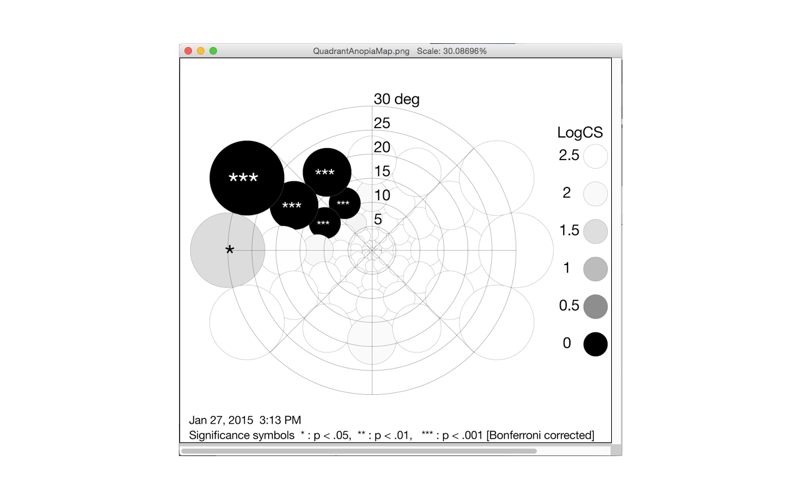
● Cortical Perimeter - by Nasanen and Raninen - is a software tool for the evaluation of contrast sensitivity of the visual field at very low cost using ordinary computer displays. Contrast sensitivity refers to the ability to see low contrasts, i.e., small differences in brightness.
● If a sufficiently large display and short viewing distance (e.g., 27-inch viewed at a distance of 20 cm) is used, a full 30-deg-field can be measured. With a 27-inch display and a viewing distance of 40 cm, the maximum field dimensions are 30 deg horizontally and 19 deg vertically. The measurement can be limited to a smaller area around the fovea, e.g., the macula area.
● In addition, it is possible to evaluate the ‘Letter Contrast Sensitivity Function’ (LCSF) of central vision.
● Further, with the ‘Training mode’, Cortical Perimeter can be used for training possible residual vision at defective visual field locations.
VISUAL FIELD TESTING
Fast perimetry mode: Full 30 degree field can be evaluated in just 3.5 –– 4 minutes.
Medium speed perimetry mode provides spatially more accurate measurement.
The measurement can be done using different combinations of stimuli and tasks: Detection of static rings, Detection of flickering rings, Identification of static letters, or Identification of flickering letters.
Size-scaling. The stimulus size increases towards larger eccentricities (eccentricity = sideward angular distance from the fixation point) for obtaining a roughly equal cortical representation as well as a roughly equal sensitivity across the visual field if the field is healthy.
Display. The program adapts to any display size. Large displays allow measurement of larger visual field areas.
LETTER CONTRAST SENSITIVITY FUNCTION
Letter contrast sensitivity function for various spatial frequencies can be measured using the same band-pass filtered letters as used in the visual field measurement. Different spatial frequencies are achieved using letters of different sizes. Spatial frequency increases with decreasing letter size.
TRAINING MODE
Some scientific studies suggest that the function of peripheral vision at defective areas after cortical lesion can be improved by intensive training, at least in some cases.
The Training mode uses methods similar to those that have been found successful in some studies. Vision is trained in defective visual field locations by measuring contrast sensitivity repeatedly for numerous times during weeks or months.
TOOLS FOR CALIBRATING THE DISPLAY
A fast and easy way to do the calibration is the ‘Visual calibration’. The gamma value obtained in this way is reasonably close to the true value. There is also a ‘Photometer Calibration Aid’ for gamma evaluation by measuring display luminance values.



